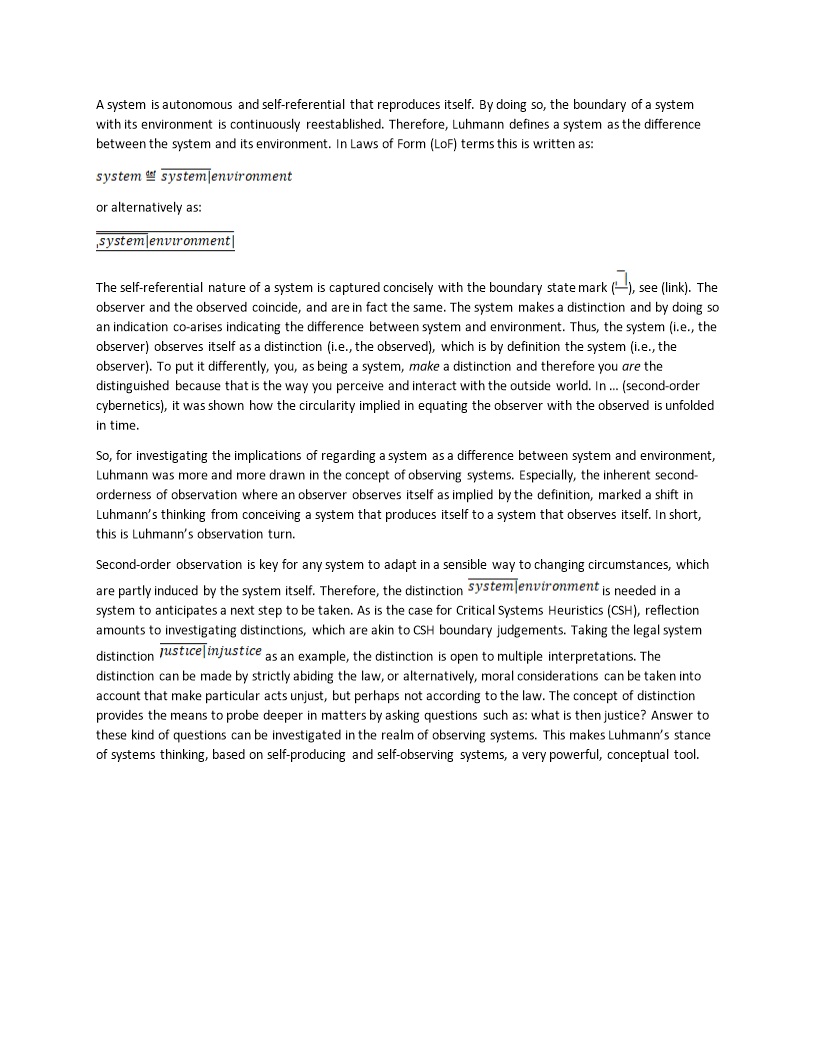The Observation Turn
A system is autonomous and self-referential that reproduces itself. By doing so, the boundary of a system with its environment is continuously reestablished. Therefore, Luhmann defines a system as the difference between the system and its environment. In Laws of Form (LoF) terms this is written as
- [math]\displaystyle{ system \;\; \stackrel{def}{=} \;\; \overline{system|}environment }[/math]
or alternatively as
- [math]\displaystyle{ \overline{\underline{\overline{_{\lfloor}system|}environment}\Big|} }[/math]
The self-referential nature of a system is captured concisely with the boundary state mark ([math]\displaystyle{ \overline{\underline{_{\lfloor}\;\;}\bigg|} }[/math]). The observer and the observed coincide, and are in fact the same. The system makes a distinction and by doing so an indication co-arises indicating the difference between system and environment. Thus, the system (i.e., the observer) observes itself as a distinction (i.e., the observed), which is by definition the system (i.e., the observer). To put it differently, you, as being a system, make a distinction and therefore you are the distinguished because that is the way you perceive and interact with the outside world. In second-order cybernetics - self-observation, it was shown how the circularity implied in equating the observer with the observed is unfolded in time.
So, for investigating the implications of regarding a system as a difference between system and environment, Luhmann was more and more drawn in the concept of observing systems. Especially, the inherent second-orderness of observation where an observer observes itself as implied by the definition, marked a shift in Luhmann’s thinking from conceiving a system that produces itself to a system that observes itself. In short, this is Luhmann’s observation turn.
Second-order observation is key for any system to adapt in a sensible way to changing circumstances, which are partly induced by the system itself. Therefore, the distinction [math]\displaystyle{ \overline{system|}environment }[/math] is needed in a system to anticipates a next step to be taken. As is the case for Critical Systems Heuristics (CSH), reflection amounts to investigating distinctions, which are akin to CSH boundary judgements. Taking the legal system distinction [math]\displaystyle{ \overline{justice|}injustice }[/math] as an example, the distinction is open to multiple interpretations. The distinction can be made by strictly abiding the law, or alternatively, moral considerations can be taken into account that make particular acts unjust, but perhaps not according to the law. The concept of distinction provides the means to probe deeper in matters by asking questions such as: what then is justice? Answer to these kinds of questions can be investigated in the realm of observing systems. This makes Luhmann’s stance of systems thinking, based on self-producing and self-observing systems, a very powerful, conceptual tool.
- Lees hiervoor:
- Lees hierna:

